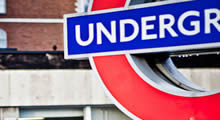
Today is voting day in the London Mayoral Election, so with people in the nation’s capital making their way to voting booths to make their voices heard – I thought it would be interesting to examine each candidates web and social media strategies. The role of digital in politics is growing year on year, and whilst Obama in the US has managed to utilise digital iniatives for both fund-raising and campaigning – here in the UK we lag behind. Nevertheless, here is where I feel the main candidates are doing it right and wrong…
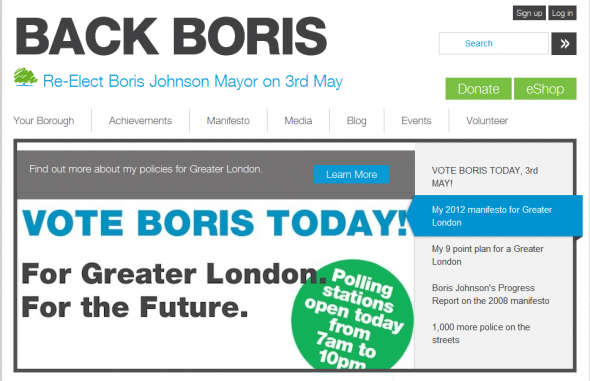
Boris Johnson (Conservative)
Boris is the incumbent so has a different starting point from the other candidates as he cannot campaign on “change and improvement”. His campaign site is found at BackBoris2012.com – not the BorisJohnson.com or BorisJohnson.co.uk that people might expect but are actually owned by The Daily Telegraph. He does run Facebook.com/BorisJohnson but his Twitter handle is @backboris2012 – this is all rather confusing and the campaign should have picked something and stuck with it across the web and social media. That a major politician does not hold their name .co.uk/com and twitter handles is a major failing in this modern age – and it runs the risk of people thinking a mock/comedy account is that of the official candidate which would not end well.
Boris’ website currently opens with an overlay video that auto-plays. Yes users can close this quite easily, but without some simple user agent checking, this video tries to auto-stream even when a voter is accessing the site from their smartphone over a 2G/3G connection. Videos are very useful in campaigns, but by election day people will be visiting the candidate’s sites to see their policies and manifestos, not to be preached at. And if they can’t view the candidate’s website because the high-bandwidth video has caused their mobile connection to stall they may just turn elsewhere. Once you get to the actual site, things are much better, however, with it well laid out and offering supporters to get involved by uploading a photo of themselves saying they will vote Boris which is then shown on an interactive map – cleverly showing that people from all London Boroughs are voting for him. The site also hosts an interactive timeline of Boris’ achievements – definitely a good way to demonstrate his successes, but this is what Facebook Timelines are for, and that would mean the timeline would have loaded in under 30 seconds!
On the social media front, @BackBoris2012 does a good job on Twitter talking about how the various parts of the campaign are going, and now retweeting those who have said they have voted for Boris to show their campaign has momentum. They made a rather huge mistake a few weeks ago by attempting to take the @MayorOfLondon to become Boris’ partisan presence on Twitter – thinking that because it had followers that people were following Boris and therefore worth incorporating it into the campaign – but people were actually following the office not the man. The Boris campaign backed down, but this just demonstrates how political campaigns simply do not grasp the intricacies of digital politics or how and why people use Twitter – and @BAckBoris2012 only has 5000 followers. As on Twitter, however, Boris’ Facebook page also does a good job at keeping people up-to-date on how campaigning is going, and has 139,000 likes with hundreds of comments on various posts.
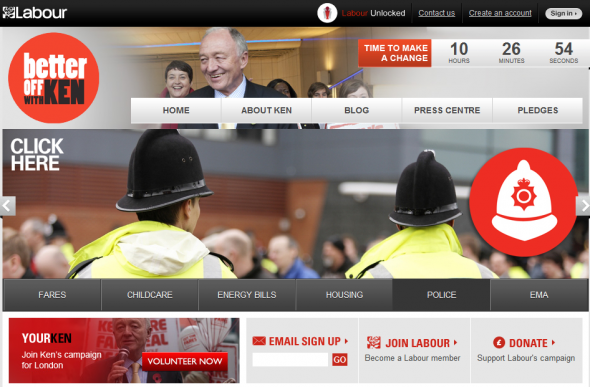
Ken Livingstone (Labour)
Ken Livingstone is in the rather difficult political position of both having been Mayor previously but having been voted out at the last Mayoral Election – so whilst he is a well known candidate he also cannot campaign on being news or different. Ken does own KenLivingstone.com, so finding his web presence is easy, but his social media presence is at Facebook.com/Ken4London and @Ken4London – again he falls down on it all being unified under one brand – his name. The person who owns @KenLivingstone is also actively offering that handle to Ken, so why his campaign have not at least taken control of it is a complete mystery. And then there is the question as how anyone believes that using “4” instead of “for” looks anything other than a hangover from the 1990s.
Ken’s website also opens with a video, but it does not auto-play meaning that it is much quicker – but again polling day is a time to let people get as quickly to your manifesto as possible – and those on smartphones are unlikely to want a video. Once you get to the actual site, it is clean and well laid out with easy access to Ken’s policies on fares, childcare, policing and other issues – but it lacks any kind of interaction. There is also some very poor copy and pasting of articles and content showing little care has been put into his online presence. There is also no way for people to show their support on the site, and it differs little from a pamphlet online – the same way political websites did ten years ago before the advent of social media.
On Twitter @Ken4London has amassed 23,000 followers and the account does a good job of outlining how the campaign is going and today retweeting those saying they have voted for Ken. Oddly, the homepage on the Twitter account is the campaign’s Facebook page and not the website – which is not ideal as it is the website that has clear access to the candidate’s policies.
Ken’s Facebook page is more of a mouthpiece of direct campaigning than a way for people to interact with the candidate and show their support and this could be the reason that he has only managed to find 6,000 likes and each post only gets a handful of comments. For a candidate where their website lacks any social interaction, it is a huge oversight to also avoid such interaction of Facebook. It should be possible for supporters to show their appreciation of the candidate with a few clicks – which would then show on their timeline and get other people to investigate, but Ken’s campaign have ignored this opportunity.
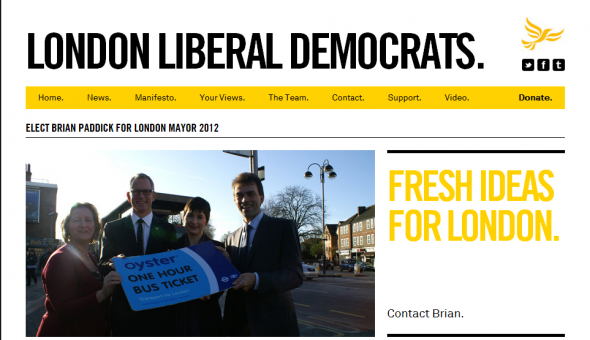
Brian Paddick (Liberal Democrat)
Brian Paddick is the only candidate from the three main parties not to have previously held the office of Mayor of London, so can campaign on changes that he could bring to the capital. His main website at BrianPaddick.com and @BrianPaddick on Twitter – but inexplicably has chosen Facebook.com/Brian4London – when Facebook.com/BrianPaddock is not taken. He also blogs at brianpaddick.tumblr.com. Maybe eh has managed to grab all these personal accounts because he is relatively unknown, but maybe this is a demonstration to future politicians to grab their now before they get famous and other people grab them instead.
Brian’s website again opens with a non auto-play video, but alongside that has the main five points of his manifesto and a direct link to his full manifesto to save any extra clicks – especially useful on smartphones, but again this video page should not be seen by smartphone users anyway. Once you click through to the site, however, things get better with easy access to his manifesto, news, and other information. Oddly, the site incorporates tweets from various London-based Liberal Democrats rather than the candidate’s own account though – which is quite confusing. There is also little in the way of interaction on the site for voters to show their support.
On Twitter, Brian has done a decent job of keeping people updated with his campaigning having amasses nearly 6,000 followers, but unlike other candidates seems to have left off Twitter for the day now and is not retweeting those saying they have voted for him, and so misses out on the opportunity to show momentum. On Facebook as well, it is easy to see how his campaigning is going, but with under 1000 likes – it doesn’t look like he has managed to engage with Facebook users at all – missing a huge market for pushing his digital message.
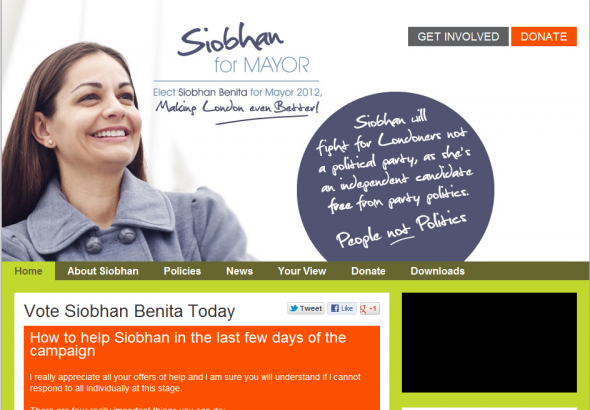
Siobhan Benita (Independent)
With trust in politicians and political parties reaching new lows, and the web opening up campaigning to those with smaller budgets and no main party support – now is a better time than ever to be an independent. Just like the other candidates, however, Siobhan does not unify her web presence under a single brand – she is SiobhanForMayor.com (although SiobhanBenita.com does redirect there), Facebook.com/SiobhanBenita, and @Siobhan4mayor. Why she wouldn’t also go with @SiobhanBenita is, again, a mystery.
Her website is clean and easy to read with easy access to her policies and news about the campaign, but it is very poorly coded with news pages not even having title tags to help them show up in search engines of be linked to when shared on Twitter or Facebook and more than a little ugly. Whilst it may look fine to most using it, these little issues have much more of an impact than people would think when talking about a digital campaign as a whole. Her website doesn’t open with a video splash screen which is a bonus, but she does have videos on the site and a Youtube channel for those wanting video content.
On Twitter she does a great job of actually interacting with other users – both supporters and journalists – showing that she appreciates the value of digital campaigning, and with 5,500 followers for an independent that is a good effort – but one that could be improved upon. She does retweet those saying they have voted for her to show momentum, but by interacting with those on Twitter she may just be helping to show a personal side to politics which could ignite some traditionally apathetic and previously burnt youth support.
On Facebook too she does a great job of interacting with her supporters posting not just news about her campaign, but also notably a cute drawing sent in from a very young supporter – again demonstrating that she appreciates the personal support and wants to engage with people. Engagement is what you need to show with a digital campaign and she does this well.
Why Does This Matter?
Digital campaigning levels the playing field as whilst it costs a lot of money to get a campaign bus to visit communities, print flyers, and employ a team of campaign promoters – having a presence online in pretty cheap. Social media like Facebook and Twitter also bring candidates closer to the people they represent, as no longer are they behind the wall of government and surrounded by their team – online they can and should be open and honest.
People should obviously pick the candidate they support on the policies that they believe the candidate will fulfil and how well they will present the aspirations and needs of their constituents. But digital politics is too important to ignore today, especially for those looking to gain the youth vote that continues to be exasperated and disappointed by politics in general.
So how did the candidates do? It is the independent Siobhan Benita that leads the way in showing the others how to engage with people on social media platforms such as Twitter and Facebook – places where grass-roots support can thrive. However, her online presence was let down in a major way by having a poorly created website, which whilst functional had many errors that will have hindered the spreading of her message. Liberal Democrat Brian Paddick was the closest to maintaining a unified presence and brand across all online profiles including Tumblr, but for some reason went with Brian4London on Facebook which is disappointing. But it is Boris Johnson who offers by far the best website (after you get past the annoying auto-play video) with clever interactivity to let voters show their support, but whilst he may have the most social media followers, he does not engage on their as well as he could.

